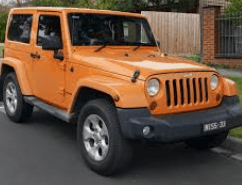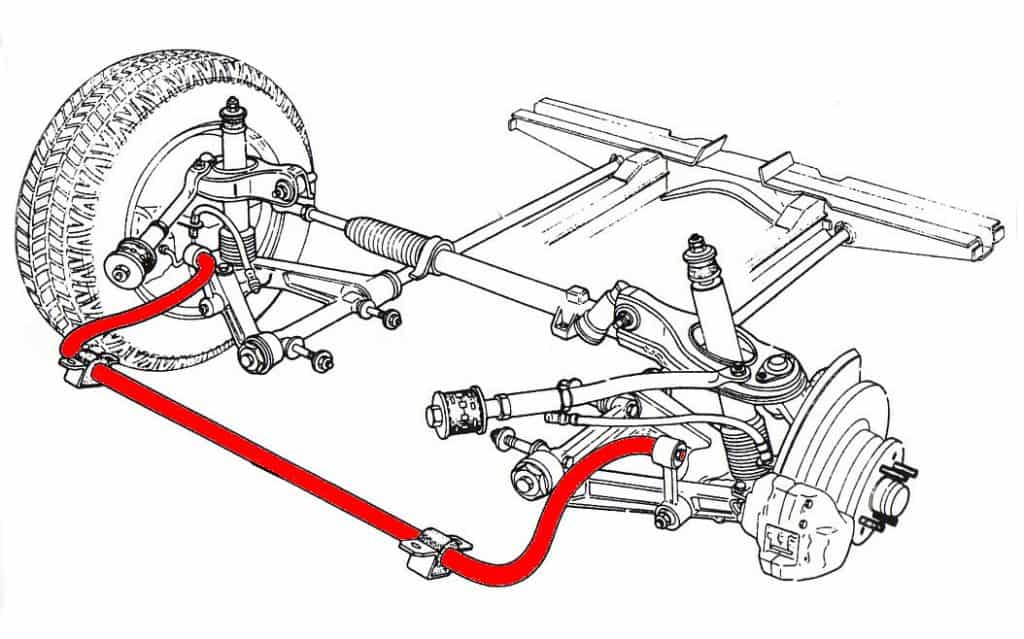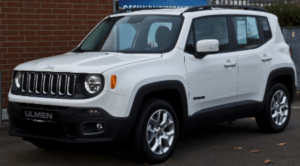- Jeep Wrangler: Bad Sway Bar Links (Common Symptoms)
- Jeep Wrangler: Symptoms of Bad Sway Bar Links
- 1. Clunking Noise
- 2. Poor Handling
- Bad Sway Bar Bushings
- Bad Sway Bar Bushings VS Bad Sway Bar Links
- Conclusion
- Jeep Renegade: Bad Sway Bar Links (Common Symptoms)
- Jeep Renegade: Symptoms of Bad Sway Bar Links
- 1. Clunking Noise
- 2. Poor Handling
- Bad Sway Bar Bushings
- Bad Sway Bar Bushings VS Bad Sway Bar Links
- Conclusion
- Buy now, pay over time.
- No hidden fees
- Sign up for our newsletter
- Sway Bar Disconnect or Flex Connect | The Right Choice For Your Jeep
Jeep Wrangler: Bad Sway Bar Links (Common Symptoms)
Sway bar links are responsible for connecting your Jeep Wrangler’s sway bar to the chassis. The job of a sway bar is to eliminate body roll by helping the tires keep better contact with the road, which improves the handling characteristics of your Wrangler. If you have a bad sway bar link, your vehicle will have increased body roll and decreased handling.
Sway bars consist of three main parts, the sway bar itself, the sway bar links, and sway bar bushings. Sway bar links connect the sway bar to the rest of the vehicle. They use bushings to make this connection smooth. Sway bar links and bushings can go bad. Sway bars can crack. Whenever this happens, there are usually noticeable symptoms.
You can still drive your Wrangler with bad sway bar links (as long as they are not rubbing something). You do need to be aware that your car or truck will not handle as well as it did before. Don’t push the vehicle hard in corners.
Jeep Wrangler: Symptoms of Bad Sway Bar Links
Your Wrangler’s sway bar links will often make noise to let you know that something is wrong. Other times, it’ll only be a lack of handling that will tip you off. Here are the most common signs of bad sway bar links. If your sway bar has a crack there will be no noise at all, just diminished handling.
1. Clunking Noise
The sway bar links will typically connect to the lower control arm on most vehicles (front end). Your Wrangler may have a rear sway bar as well. They both can make noises going down the road, but the front sway bar rattling is easier to notice when driving and much more likely to happen.
Here are the conditions in which a bad sway bar link is going to make noise.
- While not moving at all: Try turning your Wrangler’s steering wheel all the way left and all the way right. When sway bar links are bad, there doesn’t need to be vehicle movement to get a clunking sound. It will almost sound like a pop. If it only rattles or shakes when braking, it may be an issue with the rotors or caliper.
- Going over bumps: Even if the sway bar links don’t make noise while turning the steering wheel while not moving, they can make a rattle when going over bumps. This is most prevalent when making a turn and going over a bump at a higher speed (30+ MPH).
- Cornering: The sway bar’s job is to transfer the G force from the side of the vehicle that is on the outside of the corner to the side of the vehicle that is on the inside of the corner. This improves vehicle stability and reduces body roll. When the sway bar goes bad, it’ll be at its worst when cornering hard, like going down a twisty country road. It probably won’t be as pronounced on the highway.
The noise coming from a bad sway bar link/bushing would be described as clunk, rattle, or squeak.
2. Poor Handling
The sway bar’s job is to minimize body roll when steering. When the sway bar bushings/links have gone bad, it causes more weight to be placed on wheels that are on the outside of the corner. This will cause your Wrangler to handle poorly. You will also feel this body roll when you go around a corner.
Bad Sway Bar Bushings
If your Wrangler has bad sway bar bushings, the symptoms of bad sway bar bushings are going to feel nearly identical to that of bad sway bar links. Really the sway bar bushings are usually the reason why the links have gone bad. You may notice a squeaking sound coming from the wheels when you turn or go over bumps. This indicates that there is play in the sway bar bushings.
Bad Sway Bar Bushings VS Bad Sway Bar Links
Squeak = Sway Bar Bushing
Rattle or Clunk = Sway Bar Link
A bad sway bar bushing is going to make a squeaking noise, whereas a bad sway bar link is going to make a thud or clunking sound. The best thing to do is jack the vehicle up (use jack stands, be careful) and wiggle the sway bar. If you feel any play, check to see where it is coming from and replace the part accordingly.
Conclusion
Bad sway bar links can be tough to pinpoint just from noise. But, if your Jeep Wrangler is making crackling, rattling, or squeaky sounds while going over bumps, it very well could be a bad sway bar. Good luck with your vehicle.
RECALLS! January 2022 Jason, “MAZDA6 shuts down while driving” fuel pump not monitored, may be no engine light etc. SEE…
I have a 2007 h3 hummer base model. Had transmission rebuilt (Pro).My problem is that when it gets around 35…
Jeep Renegade: Bad Sway Bar Links (Common Symptoms)
Sway bar links are responsible for connecting your Jeep Renegade’s sway bar to the chassis. The job of a sway bar is to eliminate body roll by helping the tires keep better contact with the road, which improves the handling characteristics of your Renegade. If you have a bad sway bar link, your vehicle will have increased body roll and decreased handling.
Sway bars consist of three main parts, the sway bar itself, the sway bar links, and sway bar bushings. Sway bar links connect the sway bar to the rest of the vehicle. They use bushings to make this connection smooth. Sway bar links and bushings can go bad. Sway bars can crack. Whenever this happens, there are usually noticeable symptoms.
You can still drive your Renegade with bad sway bar links (as long as they are not rubbing something). You do need to be aware that your car or truck will not handle as well as it did before. Don’t push the vehicle hard in corners.
Jeep Renegade: Symptoms of Bad Sway Bar Links
Your Renegade’s sway bar links will often make noise to let you know that something is wrong. Other times, it’ll only be a lack of handling that will tip you off. Here are the most common signs of bad sway bar links. If your sway bar has a crack there will be no noise at all, just diminished handling.
1. Clunking Noise
The sway bar links will typically connect to the lower control arm on most vehicles (front end). Your Renegade may have a rear sway bar as well. They both can make noises going down the road, but the front sway bar rattling is easier to notice when driving and much more likely to happen.
Here are the conditions in which a bad sway bar link is going to make noise.
- While not moving at all: Try turning your Renegade’s steering wheel all the way left and all the way right. When sway bar links are bad, there doesn’t need to be vehicle movement to get a clunking sound. It will almost sound like a pop. If it only rattles or shakes when braking, it may be an issue with the rotors or caliper.
- Going over bumps: Even if the sway bar links don’t make noise while turning the steering wheel while not moving, they can make a rattle when going over bumps. This is most prevalent when making a turn and going over a bump at a higher speed (30+ MPH).
- Cornering: The sway bar’s job is to transfer the G force from the side of the vehicle that is on the outside of the corner to the side of the vehicle that is on the inside of the corner. This improves vehicle stability and reduces body roll. When the sway bar goes bad, it’ll be at its worst when cornering hard, like going down a twisty country road. It probably won’t be as pronounced on the highway.
The noise coming from a bad sway bar link/bushing would be described as clunk, rattle, or squeak.
2. Poor Handling
The sway bar’s job is to minimize body roll when steering. When the sway bar bushings/links have gone bad, it causes more weight to be placed on wheels that are on the outside of the corner. This will cause your Renegade to handle poorly. You will also feel this body roll when you go around a corner.
Bad Sway Bar Bushings
If your Renegade has bad sway bar bushings, the symptoms of bad sway bar bushings are going to feel nearly identical to that of bad sway bar links. Really the sway bar bushings are usually the reason why the links have gone bad. You may notice a squeaking sound coming from the wheels when you turn or go over bumps. This indicates that there is play in the sway bar bushings.
Bad Sway Bar Bushings VS Bad Sway Bar Links
Squeak = Sway Bar Bushing
Rattle or Clunk = Sway Bar Link
A bad sway bar bushing is going to make a squeaking noise, whereas a bad sway bar link is going to make a thud or clunking sound. The best thing to do is jack the vehicle up (use jack stands, be careful) and wiggle the sway bar. If you feel any play, check to see where it is coming from and replace the part accordingly.
Conclusion
Bad sway bar links can be tough to pinpoint just from noise. But, if your Jeep Renegade is making crackling, rattling, or squeaky sounds while going over bumps, it very well could be a bad sway bar. Good luck with your vehicle.
RECALLS! January 2022 Jason, “MAZDA6 shuts down while driving” fuel pump not monitored, may be no engine light etc. SEE…
I have a 2007 h3 hummer base model. Had transmission rebuilt (Pro).My problem is that when it gets around 35…
Buy now, pay over time.
Enter a few pieces of information for a real-time decision.
No hidden fees
Know up front what you’ll owe, with no hidden costs and no surprises.
Sign up for our newsletter
Sign up for our mailing list to receive new product alerts, special offers, and coupon codes.
Sway Bar Disconnect or Flex Connect | The Right Choice For Your Jeep
Sway Bar Disconnect or Flex Connect | The Right Choice For Your Jeep
When it comes to offroading, Sway Bar Disconnects are a time-honored tradition. They’re like a rite of passage. If you need to disconnect your sway bar end links, then you must be a serious Jeep nerd. While JKS Manufacturing did not invent the quick disconnect sway bar links, we did invent the Quicker Disconnect – A design that easily bolts onto your Jeep and makes off-road performance more obtainable. While often copied, JKS Quicker Disconnects are still the best solid sway bar end links you can buy for your Jeep. We’re proud of that design. At the same time, since we’re always looking for the next big idea.
JL Flex Connect system, compete with tuning springs, wrenches and storage brackets
Fast forward 25 years. What if your sway bar end links could provide better on road manners when connected? What if the links could be tuned to your driver preference? We answered those “what if’s” with the Flex Connect. Flex Connect allows the driver to tune how active the link is by swapping between 4 different sets of springs. Each set of springs offers progressively less resistance thereby allowing the end links to achieve their 3” of total travel quicker.
On the road: Much thought and engineering goes into shock absorber and springs tuning these days. Sway bars, with their solid end links, are factored into the tuning equation. A stock Jeep is expected to handle much like a regular car. When we turn corners and steer our way along winding roads, sway bars effectively increase spring rate to compensate for changing cornering loads. On Jeeps, they also have an impact on ride harshness – especially as modifications increase. Of course, as your Jeep progresses from stock to “Rock!”, articulation becomes more important than cornering speed. We can start to understand how Flex Connect benefits your daily commute. On the street, Flex Connects provide a bit of cushion to those sharp bumps and movements. With solid links on your Jeep, those sharp bumps and movements are exaggerated by the sway bars added spring rate. Your Jeep’s springs do not have time to react and provide the cushion we need. Flex Connect steps in and allows that fast action. You can tune the amount of added spring rate. You won’t win any Formula 1 races with your Jeep, but you will never cross a set of railroad tracks the same way again, we promise!
Inner workings of a Flex Connect
Off Road: Nothing is going to provide maximum articulation on your Jeep like disconnecting the sway bar. The issue is when you are on the trail or a ride that does not require all the flex your Jeep has, but the terrain and your comfort demands that you cannot ride connected. This is where the Flex Connect shines. Higher speed trails, sand dunes and even moderate rock trails are much more comfortable connected, but with the cushion the Flex Connect provides. It’s like a disconnect that stays connected. No matter if you are looking for on road or off road improvement, the Flex Connect has you covered. Simply install, and tune to your preference and enjoy the benefits.
Want to see them in action?
Available for JT, JL, JK, TJ, LJ, XJ and ZJ model Jeeps.







